The Darbyshires of New Zealand: our origins
Mark Darbyshire
2 July 2025
A journey down the Darbyshire line
The Darbyshires arrived in New Zealand in 1870, but where did we come from?
Our journey begins in the 1600s in a village called Rivington, in Lancashire in the northeast of England. For centuries, Darbyshires would live here and in the other nearby villages of Adlington, Anderton, Blackrod, and Heath Charnock.
Rivington Church records1,2 from this period are severely water-damaged, with hundreds of people missing. We can only make informed guesses about how we are related to the few Darbyshires whose records have survived.

England was on the verge of the “Glorious Revolution”. The country’s final Catholic king would be deposed, the Church of England would come out on top, and Parliament would be given primacy over the Crown. While Catholics and Nonconformists would be given the right to worship, they were not permitted to hold political office. As a result, a Nonconformist chapel was built in Rivington in 1703 for the hundreds of local Presbyterians, but most or all of our Darbyshire ancestors worshipped at Rivington Church, an ancient Anglican parish church.
There had been Darbyshires in Lancashire as early as the 1200s, and we may be related to them. They probably originally came from West Derby, but this story is lost to the mists of time. See The Derbyshires of Lancashire for more information.
Higher, Middle, and Lower Derbyshires farms
Our likely Darbyshire ancestors held farms in Rivington called Higher, Middle, and Lower Derbyshires. Until recently, you could enjoy a scone in The Little Tea Room at Higher Derbyshire’s. Middle Derbyshires hosts a historic building which was converted into a modern home. Lower Derbyshires no longer exists. A historian in 1904 wrote:
These farms, which enshrine an honoured name, also originally belonged, partially if not altogether, to the Shaws of Heath Charnock, and were in the holding of the family of Derbishire certainly as early as 1673, if not in 1642.3
Derbyshires Farm in Heath Charnock may also relate to our family.
A 1627 survey of tenements belonging to the Old Hall of Rivington shows a tenement for William Darbyshire and another for Widow Darbishire.
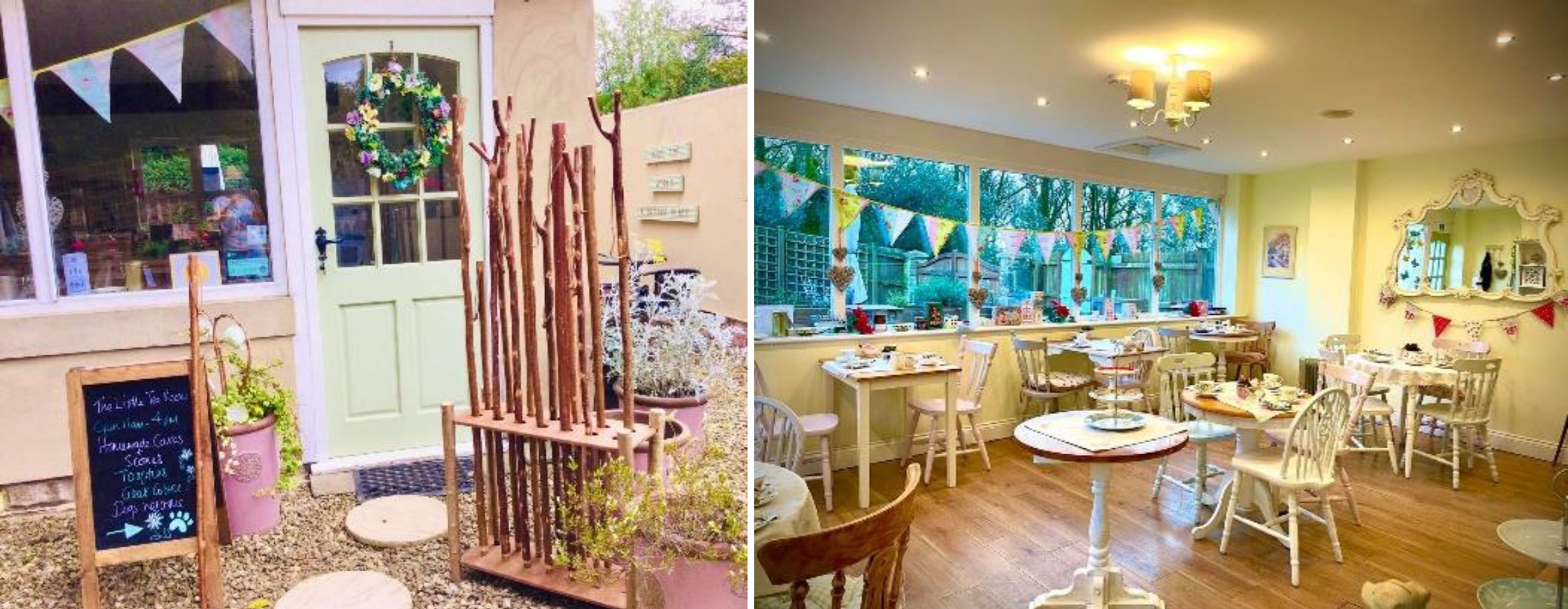
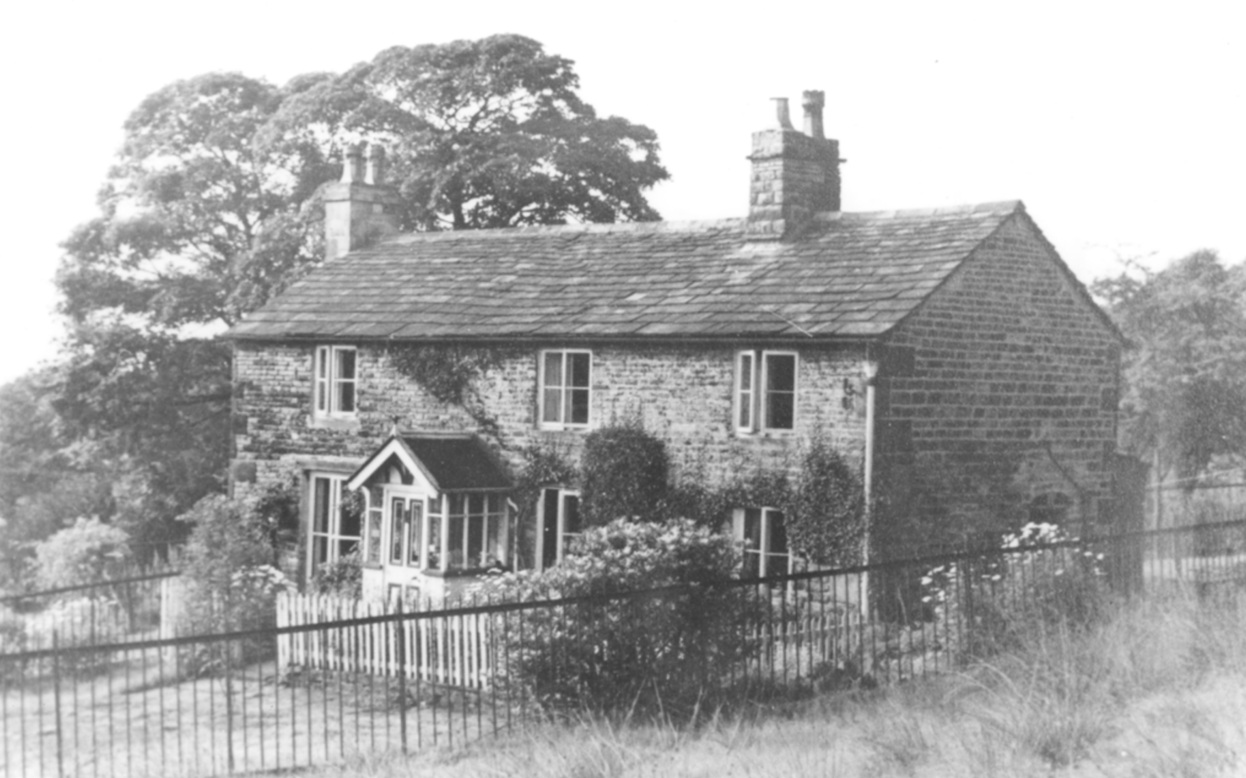
A long line of Johns?
We know a man called John Darbishire had a son (also called John) on 10 July 1686. It’s likely that they were part of this land-owning family, and that we are related to them, but we can’t know for sure. He may have been descended from another John Derbishire whose wife Eline died in 1637. Only a handful of Darbyshires are mentioned in the very patchy records from this time.
On 23 February 1642, William Darbyshier (a husbandman) and John Darbyshier (a tailor) of Rivington took the Protestation oath. In 1649/50, a John Derbyshire was elected constable in Rivington. By 1664, a John Darbishire is recorded as having one hearth in Rivington, and in 1673 a John Darbishier is again recorded in the subsidy roll with one hearth.
Fast-forward a couple of decades. On 7 February 1710, a man called John Darbyshire signed his last will and testament. He left:
- £10 for the maintenance of a minister at the nonconforming Chapel (despite himself being an Anglican)
- £5 to his brother James
- 40s (shillings) to his brother Edward
- £4 each to his sisters Elizabeth and Margaret
- 20s to his brother William
- 20s each to Thomas and Oliver (sons of James)
- 40s to John (son of James “the younger”)
- his goods and personal estate to his wife Jane
- his lands and tenements to his wife Jane during her life, and then to his brothers William and Edward (with a further £20 to be paid to James upon the death of Edward).
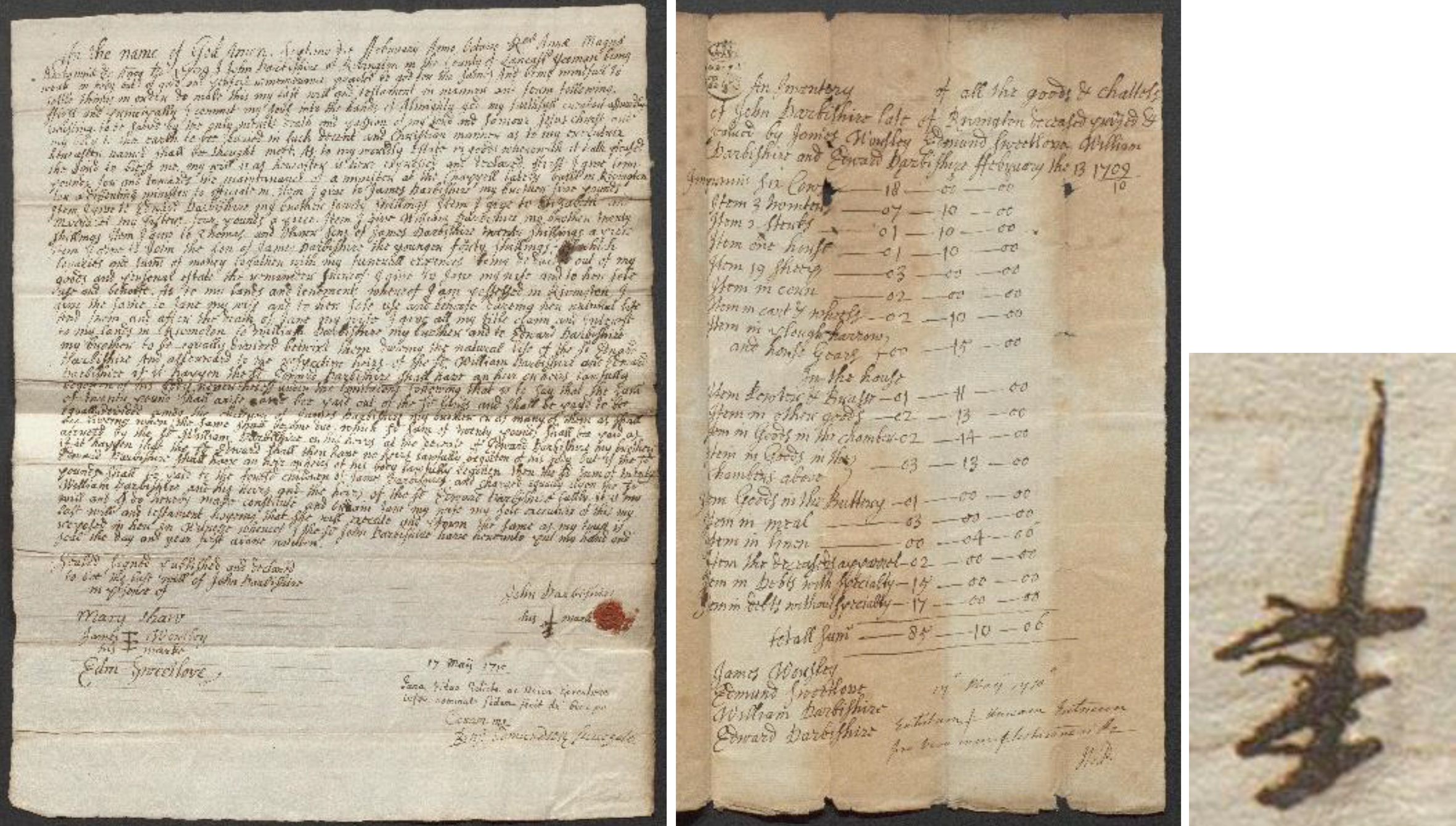
Oliver Darbyshire (?–1749)
The furthest back we can go with some confidence is a man called Oliver Darbyshire. We don’t know when or where he was born. It’s possible he’s the Oliver named in the will above and that he was John’s young nephew.
We can’t be sure how many children Oliver had (due to lost church records) but we know he fathered a daughter in 1727 (her name is unknown), Elizabeth in 1729, Ann in 1731 (but she died in 1732), Jane in 1734, James (below) in 1735, and Ann in 1738.
Oliver died in 1749 and was buried at Rivington Church.
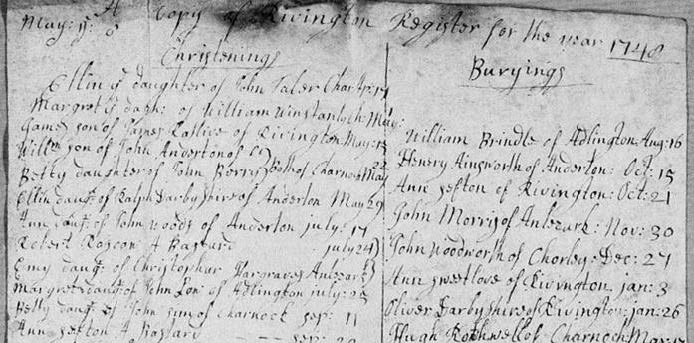
James Darbyshire (1735–?)
James Darbyshire was born to Oliver (above) in 1735 and baptised at Rivington Church. He lived in Heath Charnock and Anderton.
He had eight children: John in 1755, Thomas in 1758, Easter in 1760 (but she died in 1761), Betty in 1760, Ralph in 1763, James (below) in 1765, and twin daughters Dolly and Mary in 1767 (but they died within days of each other in 1769).
James Darbyshire (1765–1823)
James Darbyshire was born to James (above) in 1765 in Anderton and baptised at Rivington Church. He also lived in Heath Charnock, Adlington, and Rivington.
He married Alice Farnworth in 1787 in St Wilfrid’s Church, Standish. They had 11 children: John in 1787 (but he died in 1788), John in 1789, Thomas in 1792, Nathan (below) in 1794, James in 1796, William in 1798, Isaac in 1800, Banister in 1802, Alice in 1805, Jane in 1806, and Mary in 1807.
He died in 1823 in Heath Charnock aged about 57.
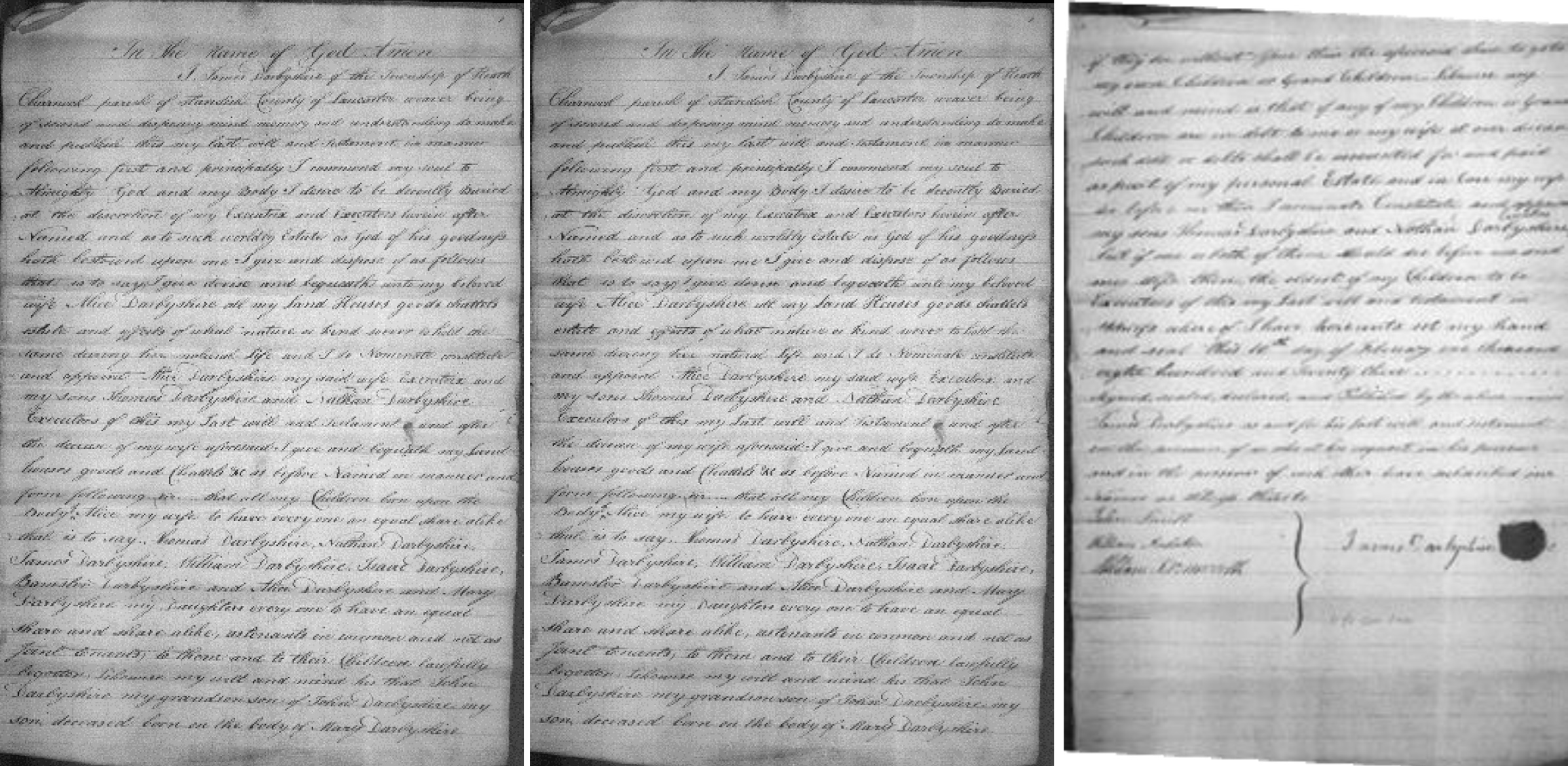
Nathan Darbyshire (1794–1829)
Nathan Darbyshire was born to James and Alice (previous section) in 1794 in Heath Charnock and baptised at Rivington Church. He also lived in Adlington and Blackrod.
He married Ann Rawlinson on 12 September 1814. They had eight children: Nancy in 1815, John in 1816, Alice in 1819, Ellen in 1821, James in 1823, William (below) in 1824, Nathan in 1826, and Isaac in 1828.
He died on Thursday 23 April 1829 aged 35. An inquest was held into his death that Saturday, and he was buried that Sunday at Rivington Church. A newspaper said:
Death from Drunkenness.—On Saturday last, an inquest was held at Blackrod, before Mr. Milne, on the body of a man named Nathan Darbyshire. It appeared that upon the Thursday preceding, the deceased and several other persons had attended the sale of some stone, in a quarry, near Blackrod, where rum, gin, and other liquors were freely distributed, and as freely consumed. The deceased, in consequence, became very much intoxicated, and fell several times while in the quarry, as well as on his way home. He died the same evening; and Mr. Eaton, the surgeon, stated it as his opinion, that his death was occasioned by excessive intoxication. The deceased has left a wife and eight young children. Another of the party fell upon a workman in the quarry, a depth of fourteen yards, but they both escaped, almost miraculously, without material injury.4
William Darbyshire (1824–1891)
William Darbyshire was born to Nathan and Ann (above) in 1824 in Heath Charnock and baptised at Rivington Church. He also lived in Blackrod where he was a shoemaker, before becoming a goldminer in Australia and a farmer in New Zealand.
He married Rachel Boardman in 1846 at St Peter’s Church, Bolton-le-Moors. While in England, they had: Ann in 1846, John in 1849, Nathan (below) in 1851, and Mary in 1856.
They left Liverpool on the Conway on 10 June 1858 and arrived in Melbourne, Australia on 15 September. They lived in Wild Duck Creek (near Bendigo) where they had more children: Rachel in 1859, William in 1861 (died 1864), Alice Ellen in 1865, and William James in 1867.
The family moved to New Zealand in 1870 and bought a farm in Maxwelltown (Pākaraka). One final child was born there: Isaac in 1870.
William died of bronchitis and failure of heart action at Southport, England in 1891 aged 66 and was buried at St Katharine’s Church, Blackrod.
DNA clues
Y-DNA is only passed from father to son, making it useful for tracking connections between distant cousins with the same surname. A Y-DNA test has shown we are distantly related to ten men around the world who have (or can trace back to) the surnames Derby, Darbie, Derbyshire, and Darbyshire.
Going back further, it is clear from Y-DNA that the Darbyshire paternal line has Germanic origins – perhaps via the Anglo-Saxons, Vikings, or Normans.
If you’re a biological male with the surname Darbyshire, it would be amazing if you could take a Y-DNA test through FamilyTreeDNA (preferably the Big Y-700) to help me better trace our complicated Darbyshire lineage over the past 800 years.
It’s less important, but still helpful, to do a Family Finder and/or Ancestry DNA test – and this one is available regardless of your biological sex.
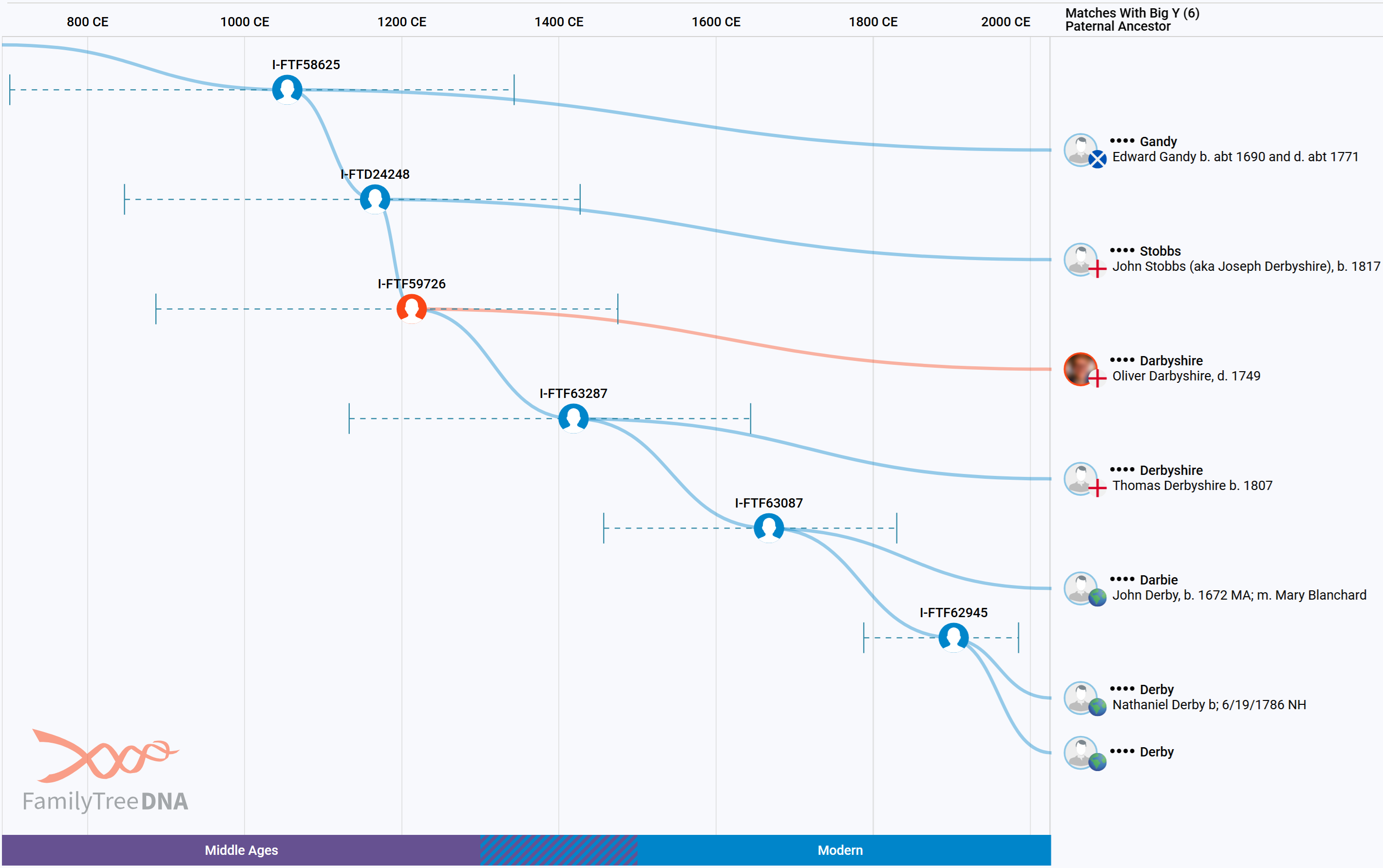
My line continued
This article is a work in progress. I will eventually add a family tree showing the next few generations of Darbyshires in New Zealand, but for now I am only tracing my own line a bit further.
Nathan Darbyshire (1851–1913)
Nathan Darbyshire was born to William and Rachel (above) in 1851 in Blackrod, England. He migrated with his family to Australia and New Zealand.
He married Christine “Teenie” Morrison in 1894. Their children were: Grace Hughes (née Darbyshire, 1897–1972), Lilian Bernice Hughes (née Darbyshire, 1898–1995), and Harold Darbyshire (below, 1900–1981).
Nathan died in Whanganui in 1913 aged 62.
Harold Gordon Darbyshire (1900–1981)
Harold was born to Nathan and Christine (see above) in Whanganui in 1900.
He married Maud Seymour in 1927. Their children were: Gordon Ward Darbyshire (1928–2020), Maxwell “Max” William Darbyshire (1933–2024), Betty Ruth Isobel Clark (née Darbyshire, 1935–1989), and one daughter who is still living.
He died in Auckland in 1981 aged 81.